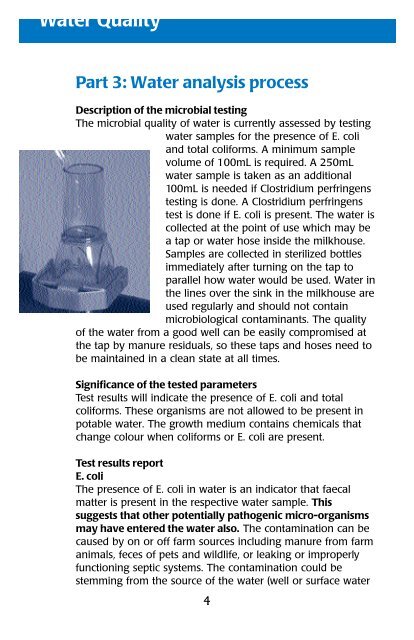Water Used To Wash Milk Contact Surfaces - Dairy Farmers of Ontario
Water Used To Wash Milk Contact Surfaces - Dairy Farmers of Ontario
Water Used To Wash Milk Contact Surfaces - Dairy Farmers of Ontario
You also want an ePaper? Increase the reach of your titles
YUMPU automatically turns print PDFs into web optimized ePapers that Google loves.
<strong>Water</strong> Quality<br />
Part 3: <strong>Water</strong> analysis process<br />
Description <strong>of</strong> the microbial testing<br />
The microbial quality <strong>of</strong> water is currently assessed by testing<br />
water samples for the presence <strong>of</strong> E. coli<br />
and total coliforms. A minimum sample<br />
volume <strong>of</strong> 100mL is required. A 250mL<br />
water sample is taken as an additional<br />
100mL is needed if Clostridium perfringens<br />
testing is done. A Clostridium perfringens<br />
test is done if E. coli is present. The water is<br />
collected at the point <strong>of</strong> use which may be<br />
a tap or water hose inside the milkhouse.<br />
Samples are collected in sterilized bottles<br />
immediately after turning on the tap to<br />
parallel how water would be used. <strong>Water</strong> in<br />
the lines over the sink in the milkhouse are<br />
used regularly and should not contain<br />
microbiological contaminants. The quality<br />
<strong>of</strong> the water from a good well can be easily compromised at<br />
the tap by manure residuals, so these taps and hoses need to<br />
be maintained in a clean state at all times.<br />
Significance <strong>of</strong> the tested parameters<br />
Test results will indicate the presence <strong>of</strong> E. coli and total<br />
coliforms. These organisms are not allowed to be present in<br />
potable water. The growth medium contains chemicals that<br />
change colour when coliforms or E. coli are present.<br />
Test results report<br />
E. coli<br />
The presence <strong>of</strong> E. coli in water is an indicator that faecal<br />
matter is present in the respective water sample. This<br />
suggests that other potentially pathogenic micro-organisms<br />
may have entered the water also. The contamination can be<br />
caused by on or <strong>of</strong>f farm sources including manure from farm<br />
animals, feces <strong>of</strong> pets and wildlife, or leaking or improperly<br />
functioning septic systems. The contamination could be<br />
stemming from the source <strong>of</strong> the water (well or surface water<br />
4
















